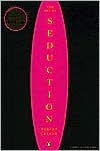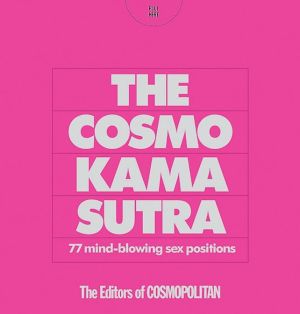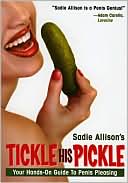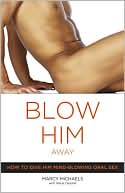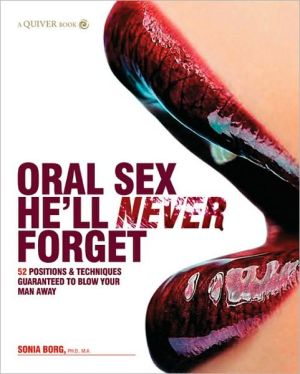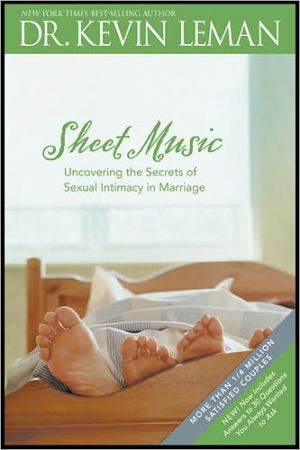Masturbation: The History of a Great Terror
Masturbation: The History of a Great Terror is a funny and frightening look at the attitudes towards masturbation throughout history and how they have affected the sex lives of anyone living and breathing today. The French biologist, Tissot, was the original spoil-sport who turned masturbation into the scourge of young men everywhere. Saying that a little self-induced pleasure caused wasting, insanity, and finally death, Tissot put the clamps (literally, in some cases) on the greatest...
Search in google:
Masturbation: The History of a Great Terror is a funny and frightening look at the attitudes towards masturbation throughout history and how they have affected the sex lives of anyone living and breathing today. The French biologist, Tissot, was the original spoil-sport who turned masturbation into the scourge of young men everywhere. Saying that a little self-induced pleasure caused wasting, insanity, and finally death, Tissot put the clamps (literally, in some cases) on the greatest relaxation inducer known to humankind. From Tissot's work to the punitive postures of the German courts to the surgical preventatives of continental Europe and England to the handbook of the Boy Scouts of America, spanking/wanking, yanking/choking, and other assorted diddling became the big no-no. Stengers and Van Neck give us the whole story and it isn't pretty, but it will fascinate everyone who agrees with Woody Allen when he said "Hey, don't knock masturbation! It's sex with someone I love." Library Journal Surgeon General Joycelyn Elders was fired for suggesting that schools teach about masturbation. Why? The story goes back to 1700 and a quack's tome titled Onania. The ensuing snowball of medical and social horror about solo sex reached its greatest mass about 1800-80 then slowly began to melt in reaction to medical and sociological evidence. Yet traces of the terror remain. Belgian historians Stengers and Van Neck tell the story with relish and exhaustive references, attempting to make some sense of what may have been a historical fluke. While the history of masturbation has been updated somewhat since the 1984 original publication of this work in French, Stengers and Van Neck's chronicle draws together many sources unavailable in English. It's also a good read. This work belongs in academic and large public libraries, necessarily those with collections in the history of science and medicine. Smaller public libraries and lay readers might consider Edward Rowan's The Joy of Self-Pleasuring (LJ 5/1/00), which covers historical aspects of masturbation in much less detail. Martha Cornog, Philadelphia Copyright 2001 Cahners Business Information.
Chapter I \ "A Shameful Vice Which Decimates Youth" (Proudhon)1\ "There is no need for us to describe here an act which is unfortunately as well known as it is shameful": it is with these words that the entry Masturbation begins in the Grand Dictionnaire universel du XIXe siècle by Pierre Larousse. This article is of a length proportionate to the importance of the subject-more than a page of text in extremely small typeface. Masturbation is not described here (except by the simple definition: "Solitary act of pleasure performed by touching the sexual parts"), but the "fatal results" are detailed at length.\ "All physicians agree that masturbation predisposes to a great number of illnesses. Those individuals who abandon themselves to it unchecked are thrown before long into a state of general weakness. . . . Its overall result is the development of phthisis accompanied by consumption and the appearance of various troubles of the nervous system. . . . In the realm of the intellect, the disorders are, if possible, even more pronounced." As for the masturbator, "both feeling and the imagination are blunted. Everything fatigues him, right up to the smallest mental exercise. He becomes incapable of the slightest intellectual work. He notices his physical and moral degeneration, but his will has lost the energy needed to remedy it. . . . The most profound melancholy and hypochondria overcome him. The memory of what he was, the thought of what he could have been throw him at times into a state of sadness filled with disgust for all the joys of life and can lead him to suicide."\ The tremolos continue at length, in dramatic perfection.2\ This is a text from 1873.3From the outset, a question arises: is it representative? Is this portrait of masturbation a faithful reflection of the conceptions of the time?\ In an attempt to answer that question, we will limit ourselves, to begin, to the period stretching from around 1815 to just a bit beyond 1873, and to ideas that could be found in France or in texts in French. Within this chronological and geographical frame, the answer is unequivocal: the Larousse of 1873 was perfectly-one might almost be tempted to say admirably-representative.\ The period opened, in 1819, with a Dictionnaire des sciences médicales in which we find: "The terrible effects of the . . . deadly habit of masturbation have been the topic of studies by the most famous physicians of all time . . . According to them, the continual excitation of the genital organs is liable to give rise to almost all the acute or chronic illnesses which can disturb the harmony of our functions."4\ From 1819 to 1873 and beyond, that was the only refrain to be heard.\ "Almost all the acute or chronic illnesses," we've just read. Combining all the different studies on the subject, as well as medical treatises and hygiene manuals, we end up with an extraordinarily broad, varied, and horrific spectrum of the diverse ills liable to strike the masturbator. Troubles of the cerebrospinal system (here we are following the medical classifications of the period): cephalalgias, vertigo, cerebral congestion, and in general "all the illnesses of the brain and the spinal column." Nervous troubles: asthenia, melancholia, hysteria, convulsions, stupidity, imbecility, and insanity. Sense organs and phonation: weakening or total loss of sight and hearing; progressive loss of smell and taste; phonation disorders. Skeletal system: rachitis, gibbosities, stunting of growth, articular rheumatism, and gout. Muscular and adipose system: weight loss, etiolation, paralysis. Cardiovascular system: palpitations, syncope, lesions of the heart and the large blood vessels, aneurysmal rupture. Respiratory system: chronic catarrh, phthisis, tubercular consumption, scrofula. Digestive system: chronic gastralgia, dyspepsia, colic. Genitourinary system: spermatorrhea, prostatitis, impotence, sterility. And the final prognosis, for the incurable masturbator: death.\ The above list, representing only a selection, was compiled from various texts by different authors. No author predicted all these ills at the same time. Each author had, as it were, his favorite ills; that was the mark of his originality. But the overall tone of the medical predictions for the masturbator was always the same: it was uniformly somber, even tragic.\ Death: this word, evoking the final outcome, resonates in the literature of the time. "The victims of genital ardor, . . . each day, take a step closer to the tomb," wrote A. Debay in his Hygiène et physiologie du mariage.5 Réveillé-Parise in 1828 viewed masturbation as the harbinger of the end, not only of the individual, but of the race itself. "Masturbation is one of those scourges which secretly attack and destroy humanity. In my opinion, neither the plague, nor war, nor the pox, nor a host of similar evils, have more disastrous results for humanity than this fatal habit. It is the destroyer of civilization, and all the more redoutable in that it works continually, undermining the generations bit by bit."6 Dr. De Bourge expressed the same idea in 1860: "This abominable practice has put to death more individuals than all the great wars, joined to the most depopulating epidemics."7 And Dr. Fonssagrives wrote in turn: "What the perverted habits of the child, prolonged into adolescence, take away from the shared patrimony of a country's forces, is incalculable, and one could almost assert that universal domination would belong to he who would extirpate this shameful leprosy from his breast." "It cannot be repeated often enough," Fonssagrives adds, "it is one of the most serious causes of the degeneration of the species."8\ What gave these pervasive ideas weight in the nineteenth century is that they were defended at the same time by physicians, hygienists, moralists, and educators, who formed a common front. Masturbation simultaneously took on the horrifying image of sin, vice, and self-destruction. It was attacked vigorously and unsparingly for its supposed moral as well as physical ravages. Moralists and physicians backed each other up. Moral and medical notions were mixed in the vocabulary of the period: lethal vice, destructive, shameful and pernicious pleasure; and fatal aberration.\ Debreyne, who was both a physician and a moral theologian, placed the physical and moral "degradation" of the masturbator on the same footing. His description is, for the period, classic: "Youth who are victims of this unhappy and shameful passion more or less lose memory, intelligence; they become stupid, foolish, imbecilic, somber, sad, melancholic, hypochondriacal, timid, indolent, cowardly, lazy." The masturbator "ends up by falling into a hideous marasmus and a disgusting decrepitude." And Debreyne inveighed: "Consider him now this mindless and degraded being; look at him, bent under the weight of crime and infamy, dragging the scraps of material and animal life through the shadows. The unhappy man! he sinned against God, against nature, and against himself. He violated the laws of the Creator, disfigured the image of God in his person, and changed it into that of a beast."9 Dr. Devay almost as energetically wrote that the inveterate masturbator "is dead to feelings for family, country and humanity."10 Monsignor Dupanloup was not a physician and spoke purely as an educator: when this evil, spreads, he wrote, it is "like the plague." "Professors, Directors, Superiors, open your eyes and be vigilant! for there is the enemy, the formidable enemy: if it penetrates, if it enters, it will devastate your house, it will destroy everything, it will pile victims upon victims, dead bodies upon dead bodies!"\ When a culprit has been caught, for Dupanloup, "an immediate and merciless repression is necessary; and this repression, is exclusion, . . . immediate." The case must be treated like a cancer. "Extirpate, and quickly, or the horrible wound will spread and ravage everything. . . . One must be merciless on this point, and throughout the term, from beginning to end. . . . I once had to advise the head of an establishment that the evil had invaded, to send home sixty-nine students; he did it, and saved his house; and it is today one of the largest and most prosperous educational establishments in France."11\ Scholars and popularizers, generalists and specialists, authors of weighty treatises and of books designed for the general public joined forces on the front of medicine and hygiene-all were fighting the same battle.\ The works dedicated specifically to masturbation-or, to use a common synonym of the time-"onanism"-are numerous. Tissot's Onanisme, an eighteenth-century classic, continued to be reedited through the next century. "It continues to be reprinted daily," noted the Larousse in 1876.12 The lengthy series of Tissot's emulators opened with Dr. Doussin-Dubreuil, who published his Lettres sur les dangers de l'onanisme in 1813.13 Listing all the subsequent works and authors would be tedious. Translations drew upon the foreign repertory. One of the most widely read works was the English Self-Preservation, translated into French as La conservation de soi-même. It is a medical treatise on weakening and disorders of the genital organs resulting from solitary habits, by Samuel La'Mert. Published for the first time in French translation in 1847, the book was already in its thirtieth edition in 1860. "Masturbation," wrote La'Mert, "is the most certain, though not always the most immediate and direct avenue to destruction." He placed particular emphasis-a feature of the English works-on the effects of "that destestable practice" on mental health. "It is a remarkable fact, that the miserable victims of sensual excess, more especially those addicted to self-pollution . . . are especially prone to insanity."14\ The authors of hygiene manuals who, like La'Mert, addressed the general public, were no less eloquent. Take for example Auguste Debay's L'Hygiène et physiologie du mariage, already mentioned. It was a bestseller in France. In 40 years, from 1848 to 1888, it would appear in 172 editions, with a total of nearly 200,000 copies.15 By the tens of thousands, Debay's readers were thus warned of the "ravages" wrought by the "fatal habit of solitary pleasures." When the malady becomes acute, Debay wrote, "the victims are hideous to look at; they inspire digust and pity."16\ Even though-in the realm of ideas-there have often been two Frances, here there is but one: no difference between conservatives and republicans, Catholics and freethinkers is apparent. The names of Proudhon and Pierre Larousse, which appear at the beginning of this chapter, were found alongside that of Monsignor Dupanloup. Littré, shining star of the positivist school, changed not a word of the definition of masturbation when, in 1855, he published a "completely revised" edition of Nysten's Dictionnaire de médecine : "shameful habit, all the more dangerous in that the opportunities to indulge in it are always present. Wasting, marasmus, degradation are the normal consequences."17 The perfect example of the republican physician in the nineteenth century was François Raspail. His Manuel annuaire de la santé would be a prodigious success.18 He too denounced the "scourge of onanism." Since Raspail's panacea, which he prescribed for anything and everything, was camphor, it is camphor that he recommends to combat this scourge. "The precaution" should be taken "to wrap the genital organs in a heavy layer of camphor powder . . . Every evening, take care to sprinkle camphor powder on the sheets, or even better, put some between the mattress and the sheets." It is also useful to "adopt, in the case of children, the use [understood: nighttime use] of bathing suits equipped with a bag of camphor at the perineum."19\ Pictures came to the aid of the written word in putting youth on its guard and inspiring it with salutary fear. The Livre sans titre, published in Paris in 1830 and subsequently reedited, has an introductory quote from Tissot: "This deadly habit kills more youth than all diseases combined." This is followed by 16 colored engravings representing the successive stages of the evil's evolution. The first portrait is that of a pink and spruce young man with an abundance of curly hair. From plate to plate, he deteriorates in ever more tragic fashion. The last plate is "the tomb": "At the age of seventeen, he expires, and in horrible agony."20\ The Livre sans titre-whose engravings are reproduced here-inspired imitations. One of them was published by Casterman in Tournai, Belgium, around 1835. Here we again find the case of the young man who, after horrible suffering, dies at the age of 17. But for good measure, we also find the case of a woman. The woman does not die; she loses her nose. The text reads: "Sauvages reports that a peasant woman, as a result of indecent acts, lost her nose. In its place there remained only a small bump barely the size of a pea; her lips had nearly disappeared, and the opening of her mouth was so shrunken that it was difficult to insert one's small finger in it." The engraving accompanying the text shows a woman with a bandage over the spot where her nose would be, with the caption: "She lost her nose through a shameful vice! . . ."21\ If one was not able to slip a young man a copy of the Livre sans titre, one could take him to an anatomical museum: to the Paris office of Dr. Bertrand, for example, at the beginning of the nineteenth century. Here, an entire room was devoted to onanism, with wax figures representing:\ l. A young man reduced to mortal agony and in the last stages of emaciation by masturbation. 2. A young man with an interesting face, enjoying perfect health. 3. The same man, become hideous through masturbation. 4. A young woman of great beauty, enjoying perfect health. 5. The same woman, six months later, become very ugly, thin and exhausted from having succombed to solitary vices, of which she was lucky to have rid herself through marriage, as well as other figures representing various illnesses suffered by the masturbator.22 A visit was highly recommended: "This very curious office," wrote Doussin-Dubreuil, "had a much greater effect on the masturbators who visited it, than all that has been written on the dangers of masturbation."23\ A great fear of masturbation thus truly existed in the nineteenth century. The texts just quoted are unquestionably heavy-handed; they were designed to grab public attention. In all likelihood, the overall atmosphere of the period was less tense than these documents lead us to believe. It is also true that alongside what was openly said and written, there was much that was toned down, insinuated, implied-for, let us not forget, we are dealing with a "shameful" vice of which decency does not always permit one to speak. Yet despite all that, the very existence of a pervading fear felt by parents, educators, and young people themselves was incontrovertible.\ Revelations of concrete cases fed that fear. The authors knew the victims of the evil. They pointed them out, especially those who had perished from it. The young Gaétan Viaris, in a letter addressed to his father in August 1832, explained that one of his schoolmates has just died from masturbation. "Having developed a taste for it, he did it so often and in so few days, that this previously big and round-faced boy, became thin, bony, and worn and finally died in horrible agony." Gaétan Viaris is a clever boy, having invoked this "fearful example" in order to ask his father for money so that he can purchase normal sex.24 The Goncourt brothers, who indefatigably collected Parisian gossip, recorded Sainte-Beuve's merciless attack on poor Augustin Theirry, who has gone blind: "This blindness, which led so often to his being compared to Homer, was not even the result of the pox, but simply of masturbation."25 Later, the Goncourts told the story of a widow and her son. A perverse friend took pleasure in "trying out the power of erotic books and obscene pictures" on the young boy, with so much success that the latter "died of exhaustion from masturbation."26 Novels, like life itself, also provided examples. Paul Bonnetain, in Charlot s'amuse, told the sad story of a young man who, victim of his vice, falls into a stupor before throwing himself into the water.27 Prosecuted for obscenity, Bonnetain defended himself by claiming to have written a "scientific novel." He was acquitted, in any event.28\ The result of fear was an arsenal of measures taken to combat the evil. The watchwords that dominated the combat were: prevention, restraint, supervision, cure.\ Prevention came first. It was a question, in all cases, of forestalling not only masturbation, but also nocturnal emissions, which were also judged to be highly dangerous.\ One of the principal weapons in the battle for prevention was gymnastics, physical exercise. There was nothing like it for the healthy fatiguing of children's bodies and for bringing them to the brink of a profoundly refreshing sleep. "Gymnastic exercises, pushed to the point of fatigue," wrote Debay, "have the effect of transferring the excess of vitality fixed in the genital organs to the skeletal and muscular systems; they must be practiced twice a day, and particularly in the evening. The masturbator, fatigued by his exercises, fall asleep naturally almost before his head touches the pillow, without indulging his vice."29 A good method consisted in "rewarding exercise practiced before bedtime; for example, drawing water from a well, grinding coffee, or turning a spinning wheel until the point of fatigue; when the subject says he is tired, urge him to turn more by doubling the reward. The extreme lassitude into which the child falls will not permit him to think about his vice."30\ All sports and outdoor games were recommended. Certain authors, however, expressed reservations. For example, girls were to be prevented from playing on hobbyhorses, and boys from sliding down bannisters.31 Also banned "for reasons easy to imagine" was "the climbing rope," which "could even be counterproductive to the goal of preservation."32 Dr. Londe advised also that "country outings and hunting" should be practiced only under continual surveillance. "In fact," he clarifies, "without that, the young man disappears into the woods and finds within several minutes of that solitude all that is capable of intoxicating his imagination and leading him to satisfy his deplorable penchant."33\ But the sport endorsed by all without reservation was swimming. It was, along with baths and cold or warm water ablutions of the genital organs, considered an excellent preventative as well as a remedy, offering the double benefit of muscular fatigue and cleanliness. Rozier furnished on this point a "scientific" explanation: "Bathwater, by dissolving and carrying away the saline, earthy and alkaline molecules which perspiration deposits in the pores and the exhaling and absorbing orifices of the skin, eliminates a source of irritation which can sympathetically excite the other organs. Considered in this light, the bath is as much a preserver of chastity as it is one of the first cosmetics."34 A rigorous hygiene would also prevent the appearance of Ascaridae worms and, with them, dangerous itching.\ The child, clean and tired, would throw himself on the bed and falls deeply asleep. This would not eliminate the need, however, for vigilance in regard to his surroundings. The bed, first of all, must be hard: feather mattresses and soft blankets that incite lethargy were to be banned. The same goes for children's chairs: seats of straw or of wood were preferable and, in serious cases, benches of stone or marble. Nightclothes were to be selected with caution. Certain writers advocated a long shirt enveloping the feet and equipped with a seat flap "that must be tightly fastened in the evening after the excretory needs have been satisfied."35\ The position to be adopted by the sleeper was regulated: several authors advised against sleeping on the back or the left side. "If his penchant is too pronounced," some propose putting the child to bed "with an adult person of the same sex."36 "According to the case," suggested Dr. Crommelinck, "chose a male or female bed companion of a reasonable age and who is not unaware of the problem. It is not a teacher who is needed here, but a trustworthy friend."37 In the case of older individuals, this Belgian doctor came up with an imaginative solution that is particularly reliable in the event that the "fatal desire overcomes you in bed": "Keep a set of parallel bars in your room: they don't take up much space and won't even wake up your neighbor, no matter how violent the exercises which you should practice enthusiastically for half an hour or longer, as needed."38\ Diet is another aspect of bodily hygiene. Here too, there is unanimity, at least on the basic principle: sobriety is the rule. Simple but fortifying foods were prescribed and all exciting foods were to be avoided. The list of recommended and non-recommended foods is too long to detail here. Spices, rich meats, and venison were generally banned. Salted fish was also sometimes suspect; considered as "having very marked aphrodisiacal properties." "It has been observed," wrote Dr. Pavet de Courteille in his Hygiène des collèges et des maisons d'éducation, "that peoples who live only on fish are much more precocious in puberty than others, and far more inclined to overindulgence."39 Wine, too, was often suspect.\ Last, it was important to limit the amount of liquid consumed. "Abundant urine retained too long in the bladder . . . draws too much blood to the very part from which we want to draw it away," explained Friedlander.40 Crommelinck shares his opinion and adds prudently: "Urinate quickly, do not shake your penis, even if it means having several drops of urine drip into your pants," so as to "scrupulously avoid touching the genitals."41\ An imperative naturally accompanies this encyclopedia of diets: it is mental hygiene, completely indissociable from bodily hygiene. Here, the imagination, the "madwoman in the attic," was the great enemy. The mind is to be occupied with "objects which banish any thought of sensual pleasure."42 The study of the natural sciences, "requiring by nature a great effort," was often recommended: it had the advantage of not exciting any passion.43 Commelinck gives his practical advice: "Keep a collection of the best poets at hand, and as soon as the desire to masturbate overcomes you, give yourself fifty or a hundred verses to learn by heart, giving preference to selections on morals, philosophy or history. The more difficult the piece, the better."44 Dances and the theater were pernicious, as were conversations upon light or ambiguous topics. Books, brochures, newspapers, and paintings to which children have access were to be carefully chosen. Even in the case of the Bible, Friedlander emphasizes, only selections were to be read.45\ If, despite all these preventive measures, the danger persisted, additional steps would need to be contemplated: appropriate measures would have to be taken to prohibit the child from committing the shameless act.\ The most simple method, during the night, was to tie the child's hands to the bed rails. Several physicians-for example, Dr. Simon in his Traité d'hygiène appliquée à l'éducation de la jeunesse (1827)-recommended this rudimentary practice.46 Accounts confirm that this became common practice rather quickly. There were also variations on the procedure. Doussin-Dubreuil was familiar with the case of an "unfortunate young man" who "had had the courage during the last year of his life to spend his nights in a chair, a collar around his neck and his two hands tied with two ropes attached to both sides of his chair."47\ Instruments represented another level of sophistication. "In our time," a medical dictionary of 1881 read, "a great number of instruments have been conceived for boys or girls. These instruments must all fill the same prescription: to imprison the genital organs of the child or the adult, in such a way that he is unable to reach them, while still permitting menstrual flow and micturition. It is easy to see what a variety of forms these appliances might take."48\ At the beginning of the nineteenth century, we find reports of a "very skilled mechanic" in Paris who "has invented several instruments as ingenious as they are efficacious in combatting the furor of onanism in children of both sexes" and of a "hernial surgeon" who "is the inventor of an undergarment that is to be worn day and night, and which serves the same purpose."49 The "hernial surgeon" in question, Jalade-Lafond, had moreover invented something better than an undergarment: it was an extremely complicated bandage that permitted the child "full liberty of all his limbs," but which worked like an abdominal straitjacket from which he was incapable of liberating himself.50 The ingenuity of later manufacturers would focus on the development of an entire series of belts. A "surgical bazaar" in Paris in 1860 offered an entire range. "These instruments," a handbill said, "are an insurmountable barrier against those solitary habits which religion and society have condemned." They "are worn without the slightest sensation of discomfort, as they have no metal fittings."51 The list of such sometimes rather extraordinary inventions is long.\ All of this was not the fruit of the wild imaginings of a few obsessed souls. The Larousse-again the Larousse-endorsed the methods in 1873: "One can even resort to varied mechanical instruments designed to prevent the child from abusing himself."52 It must be noted, however, that the unanimity of the medical corps, often so striking on the question of masturbation, was missing on this point. A number of doctors were partisans of the devices, especially in serious cases, but others opposed them. The instruments risked, some said, either attenuating the child's sense of responsibility or provoking feelings of revolt. Their efficacity, moreover, was questionable. "The ingenuity of the researchers seems to have cooled after a host of unsuccesful endeavors," Fonssagrives wrote in 1870.53\ What is clear is that the instruments were well-known in the nineteenth century. Literary works alluded to them. In 1848, Flaubert derided "the Gentleman who has invented, for the statues in the Nantes Museum, tin plate fig leaves that look like anti-onanism instruments," that is to say, he added, "like shameful metallic underpants shining like polished saucepans."54 The theme appears again more than thirty years later in Bouvard et Pécuchet.55 The two heroes, who are raising young Victor, suspect him of a "bad habit." Pécuchet "questioned his disciple in such a way as to give him ideas, and before long, he had no doubts. Then he called him a criminal, believing all was lost."56 (That nineteenth-century expression would have worked just as well as the quote from Proudhon as the epigraph of this chapter.) "Buy him an appliance," Bouvard advised. Eventually, the two friends decided to tire young Victor out with exercise and take up "cross-country races."\ Even if recourse to instruments must have been relatively rare-they were often, incidentally, expensive-the notion was certainly present throughout the century. 57 A teacher from Anvers, in Belgium, introduced his new invention, an anti-masturbatory school bench, as late as 1873. This bench "prevents schoolboys from crossing or closing their legs." "Thus both the rubbing and the heating of the genital parts are avoided, and one of the causes of masturbation is thus eliminated, a malady that could have wrought the greatest of havoc will have been banished from the school."58\ Constant surveillance was as necessary as prevention and restraint. Parents and educators were instructed and enjoined to be incessantly on their guard throughout children's early years and adolescence, to be vigilant for the slightest suspicious sign, to keep a lookout for the smallest clue to the presence of the evil. Clues might have included a hint of pallor or a slightly drawn look, abnormal sweats, any tendency toward weariness, and, of course, a stain on nightshirt or sheets. A rigorous investigation was required, from the moment suspicion arose. "The investigation is laborious, it is sad," Fonssagrives declared, "but it must be conducted forcefully, until the end. What matter of greater importance could there be for the family?"59\ Remaining vigilant for even the smallest clue was all the more important in that it would permit energetic intervention from the very start of the malady, since once the vice was established, the cure was often exceedingly delicate and difficult. There was no true remedy that was readily applicable. The malady could be arrested only by energetically applying a series of converging techniques, both psychological and physical. On the psychological level, moral and religious sermons were designed to make the masturbator, gripped with fear and shame for his behavior, envisage the calamities that awaited him. On the physical level, the same measures that been prescribed for preventing or restraining the child's behavior were to be continued; fatiguing him was particularly recommended. Prescribed too were various medicinal products, for example, calming herbal teas made from various plants: orange flowers, centaury, violets, marsh mallow, couch grass, purslane, lettuce, water lily. In the event of weakening, however-and weakening, alas! occurred quickly-vigorous tonics were to be administered. Each doctor had his favorite products and procedures, but none dared to promise a sure cure: the malady was perverse.\ If masturbation was a serious problem for physicians, it was no less a thorny one for confessors. Monsignor Bouvier wrote in his Dissertatio in sextum Decalogi praeceptum: "The execrable habit of masturbation, when it is inveterate, drags confessors into a sort of dispair. It is difficult to prudently determine if one can, if one must allow penitents who have surrendered to this vice to partake of the sacrements of penitence and of communion. It is to be feared that they will stray from the confessional and become even more immoral if they are harshly treated; if they are treated indulgently, they will continue to wallow in the mire of the vice."60\ Bouvier recommended making a distinction between the sinner inspired by "malice or indolence" and the sinner who succumbed to "the violence of temptation": "In the first case, absolution must be put off until the sinner has truly mended his ways; but in the second, one must, through the grace of absolution and by the holy Eucharist, seek to aid the unfortunate penitent who is fighting against a tyrannical passion and who is contrite." In this way, there remained hope for a mending of the ways that would be extinguished were the sacraments to be withheld.\ Monsignor Bouvier's grand finale is particularly interesting. "Sometimes," he wrote, "marriage must be recommended, to those capable of entering into it, as the sole, or at least the most effective, remedy." Marriage was in fact-it was often repeated during this period-the only cure that could be considered radical, to be imposed, of course, at the first instant that age permitted. Dr. Rozier spoke of "immolating vice at nature's most cherished altar, the altar of marriage,"61 and Dr. Commelink spoke of a "radical, definitive cure."62 The Larousse called it a "heroic remedy" that "has truly cured more than one unfortunate who would otherwise have been lost without this option."63\ Nineteenth-century families could not fail to hear the warnings and take them into consideration in their marriage decisions. In his correspondence with Queen Victoria in 1853, King Léopold I of Belgium explained why he was anxious to marry off his eldest son, who was only 18 (the future Léopold II). One of the reasons, he said, was that "young men often fall into a habit destructive of health, mind, spirit, in short everything," a habit, the king added, for which marriage is often the "only" method of salvation. For further information on this delicate topic, Leopold referred Victoria to her husband, "dear Albert."64\ The various elements outlined above allow us to draw one sure conclusion: the fear of masturbation during the period we've considered-and that stretches, let us recall, from around 1815 until a bit beyond 1875-was truly a social phenomenon.\ The obvious question: "in what society?" is a legitimate one. Most of the texts that we have quoted have more than a hint of the bourgeoisie, and the upper bourgeoisie at that, about them. The dietary prescriptions, which mention simple "but succulent" dishes, and the exhortations to study the natural sciences are not addressed to the popular classes. There is hardly anything except Raspail's camphor that is frankly democratic. One can certainly imagine that once the ideas eventually filtered down into the popular classes, the methods were far more rudimentary. The anti-masturbatory belts were quite expensive, but a couple of bandages solid enough to imprison the hands could be cheaply fashioned. Yet this is pure speculation: we have no idea to what depths and across what strata of French society the fear of masturbation penetrated. The sources are mute. It is one of the great sources of consternation for the historian and an invitation to his or her modesty: at a distance of barely a little more than a century, the dimensions of a social phenomenon of this magnitude have faded into the distance and elude the historian's grasp.\ Even if the depth of its hold cannot be fully known, the term social phenomenon is nonetheless justified. Two questions naturally arise: where did this phenomenena come from, and when did it begin?\ Notes Chapter I\ 1. P.-J. Proudhon, De la Justice dans la Révolution et dans l'Eglise. Nouveaux principes de philosophie pratique, vol. I (Paris: 1858), p. 336.\ 2. Grand Dictionnaire universel du XIXe siècle, vol. X (Paris: 1858), pp. 1320-22.\ 3. See also, at about the same date, the entry Onanism in Dictionnaire de la Conversation, which summarizes the "terrible consequences" of the vice (2nd ed., vol. XIII [Paris: 1872], p. 732.\ 4. Fournier and Béguin, entry Masturbation in Dictionnaire des Sciences médicales, vol. XXXI (Paris: 1819), p. 108.\ 5. Hygiène et physiologie du mariage (Paris: 1848), p. 226. Same in 57th ed. (Paris: 1872), p. 226.\ 6. Réveillé-Parise, "Traité d'hygiène appliqué à l'éducation de la jeunesse, par le Docteur Simon," Revue médicale française et étrangère (1828), vol. II, p. 93.\ 7. J.-B. de Bourge, Le memento du père de famille et de l'éducateur de l'enfance, ou les conseils intimes sur les dangers de la masturbation (Mirecourt, 1860), p. 28. Dr. Demeaux similarly emphasized: "This vice is considered, by all who have studied the question with real care, as a true scourge of humanity . . . The evil has taken on the proportions of a huge epidemic." (J.-B. Demeaux, Mémoire sur l'onanisme et sur les moyens d'en préveneir ou d'en réprimer les abus dans les établissements consacrés à l'instruction publique (Paris: 1856), pp. 6-7.\ 8. J.-B. Fonssagrives, L'éducation physique des garçons (Paris: 1870), pp. 302 and 313. Fonssagrives was a professor in the Montpellier Medical School. On his ideas, see also G. Vigarello, Le Corps redressé. Histoire d'un pouvoir pédagogique (Paris: 1978), pp. 184-85.\ 9. P. J.-C. Debreyne, Essai sur la théologie morale considérée dans ses rapports avec la physiologie et la médecine, 4th ed. (Paris: 1844), pp. 64-67; 5th ed. (Brussels: 1846), pp. 68-71. On Debreyne, see the entries in the Dictionnaire de Biographie française, vol. X, col. 449, Dictionnaire d'Histoire de Géographie ecclésiastiques, vol. XIV, col. 143-44, and Catholicisme, vol. III, col. 498.\ 10. F. Devay, Hygiène des familles ou du perfectionnement physique et moral de l'homme, vol. II (Paris: 1846), p. 72.\ 11. Monsignor Dupanloup, De l'éducation, vol. III (Paris: 1897), pp. 437 and 451-53. The book was first published in 1862.\ 12. Grand Dictionnaire universel du XIXe siècle, vol. XV (Paris: 1876), p. 235, under Tissot. In the preface to his Essai sur la théologie morale, cited earlier, Debreyne noted: "There are few, even among the clergy, who have not read this opuscule" (p. VI). In addition to the multiple reeditions of Tissot, there were also a significant number of enlarged editions and adaptations. For a very partial overview, see T. Tarczylo, Sexe et liberté au siècle des Lumières (Paris: 1983), pp. 293-94.\ 13. We know that Doussin-Dubreuil's work was particularly successful because it was republished in 1839, in a revised and enlarged edition, in the popular series, the Manuels-Roret (J.-L. Doussin-Dubreuil, Nouveau manuel sur les dangers de l'onanisme, et conseils relatifs au traitement des maladies qui en résultent, ed. J. Morin [Paris: 1839]).\ 14. Samuel La'Mert, Self-Preservation (Manchester: S. Gilbert, 1841), pp. 52, 48, 2. It was also published in French under the title: La Préservation personnelle. The 1860 edition (at the Bibliothèque Nationale in Paris) is announced as the 52nd edition, but the first French edition, in 1847, was already numbered as the "22nd edition," given the fact that the translation was based on the 22nd English edition. Publicity in the press helped boost sales: see, for example, the announcements in the Indépendence belge, September and October 1849.\ 15. See the catalog entry in the Bibliothèque Nationale, Le livre dans la vie quotidienne (Paris: 1975), pp. 13-14.\ 16. A. Debay, Hygiène et physiologie du mariage (Paris: 1848), pp. 226 and 335.\ 17. P. H. Nysten, Dictionnaire de médecine, 7th ed. (Paris: 1839), p. 602; 10th ed., entièrement refondue par E. Littré et Ch. Robin (Paris: 1855), vol. II, p. 780.\ 18. See the catalog Le livre dans la vie quotidienne, cited above, p. 13, and D.-B. Weiner, Raspail, scientist and reformer (New York), pp. 146-47. First published in 1845, the Manuel Annuaire sold around 200,000 copies in five years. It was still popular a half-century later. Van Gogh, painting everyday objects in 1889-a candlestick, a bottle, his pipe-included Raspail's book among them (see P. Lecaldano, Tout l'oeuvre peint de Vincent van Gogh, vol. II (Paris: 1971), p. 217, no. 629.\ 19. F.-V. Raspail, Manuel annuaire de la santé ou Médecine et pharmacie domestique (Paris: 1845), pp. 211-12. The use of hygienic underwear with camphor had already been recommended by Raspail in his Histoire naturelle de la santé et de la maladie chez les végétaux et chez les animaux en général, vol. II (Paris: 1843), p. 507: "I know of no other more powerful way to banish all thought of solitary pleasures in children than to have them regularly wear, under one pretext or another, hygienic underwear, that is to say underwear having camphor powder in the area of the private parts. The powder is to be replaced nightly, if necessary; then camphor powder is also to be put on the bedsheets. It would be desirable for this practice to be adopted in secondary schools and boarding establishments." Raspail is indignant at the fact that animosity towards his ideas-of political origin-might prevent the adoption of such an effective procedure: "Those who carry political hatred to the point of proscribing, out of fear of having to pronounce an author's name, a medication capable of preserving our young generation from a vice which so sadly ravages its ranks, is guilty in our eyes, of an offence against parents and country." Camphor, given Raspail's passion for it, took on a symbolic role: it became the "republican medicine." See particularly on this topic D. Ligou's preface to François-Vincent Raspail ou le bon usage de la prison (Paris: 1968), pp. 28-30.\ 20. Le livre sans titre (Paris: 1830); 2nd ed. (Paris: 1844). The author of the Conseils sur les moyens de corriger les jeunes détenus de l'habitude de l'onanisme (n.d.) highly recommends the Livre sans titre [Untitled Book] to young men in prison, where masturbation was rife: "The text of this work is mediocre," but "its usefulness lies entirely in the illustrations," which were capable of "inspiring great terror."\ 21. Antidote moral contre les suites funestes d'un vice impur qui exerce les ravages les plus affreux sur le genre humain (Tournai, n.d.), pp. 54-55. The Bibliothèque du Séminaire de Tournai has a copy.\ 22. Précis historique, physiologique et moral des princiaux objets en cire préparée et coloriée d'après nature qui composent le Museum de J.-F. Bertrand Rival (Paris: 1801), p. 309. See also J.-P. Aron and R. Kempf, Le pénis et la démoralisation de l'Occident (Paris: 1978), p. 189.\ 23. J.-L. Doussin-Dubreuil, Lettres sur les dangers de l'onanisme, 3rd ed. (Paris: 1825), p. 96. "I have heard," added Doussin-Dubreuil, "that M. Bertrand had moved it to Marseille." Another "medical museum" in Paris at the end of the century, with equally edifying figures, is mentioned in P. Bonnetain, Charlot s'amuse, 2nd ed. (Brussels: 1883), p. 268.\ 24. Letter of August 20, 1832, signed "Gaétan," published in the May 23, 1976, edition of Le Monde. Pierre Ordioni, who presented the document, did not identify the Gaétan in question, but the information he provided on his father-baron of the Empire, battalion leader of the 56th in 1832-allow us to identify him as Gaétan Viaris, born in 1812 (see A. Révérend, Armorial du Premier Empire, vol. IV [Paris: 1897], p. 365; Almanach royal, 1832).\ 25. Edmond and Jules de Goncourt, Journal, ed. Ricatte, vol. VI, 1863-1864 (Monaco: Imprimerie Nationale, 1956), p. 184 (entry for February 29, 1864)-Under the Restoration, the case of the duc d'Angoulême, whose deformities, tics, and manias were attributed to a "schoolboy vice," was cited (see J. Turquan, Le dernier Dauphin. Madame, duchesse d'Angoulême [Paris: 1909], pp. 132-33 and 136-37, and J. Cabanis, Charles X, Roi ultra [Paris: 1972], pp. 442-43). His case, which had struck a chord with the public, would continue to be cited in later years: see, for example, Gustave Flaubert, Bouvard et Pécuchet, ed. A. Cento (Naples-Paris: 1864), p. 568 ("it is claimed that the duc d'Angoulême did it"), and Henry Céard, preface by P. Bonnetain, Charlot s'amuse, 2nd ed. (Brussels, 1883), p. IX ("the onanical passion which the duc d'Angoulême, a prince, did not disdain").\ 26. Journal, vol. XVII, 1890-1891 (Monaco: 1956), pp. 24-25 (entry for March 28, 1890).\ 27. First and second editions (Brussels: Kistemaeckeers, 1883). Henry Céard had given the novel a preface in which he declared that Bonnetain, in his description of masturbation, was "moral like Tissot." On Bonnetain, see Dictionnaire de Biographie française, vol. VI, col. 1028-29.\ 28. The trial took place in December 1884, before the Assize Court of the Seine; see the reports in the Journal des Débats and Temps, December 29, 1884, and in Indépendence belge, December 30,1884, as well as the lead piece in the new expanded edition published by Kistemaeckers in 1885; see also A. Zevaes, Les procès littéraires au XIXe siècle (Paris: 1924), pp. 236-38. The editor Kistemaeckers was also prosecuted for the publication of Charlot s'amuse, but in Belgium, and was also acquitted (see C. de Cruyenaere-Baudet, entry Kistemaeckers in Biographie Nationale, vol. XXXVIII, col. 421).\ 29. A. Debay, Hygiène et physiologie du mariage, 57th ed. (Paris: 1872), p. 228.\ 30. Hygiène et physiologie du mariage, p. 336.\ 31. M. Friedlander, De l'éducation physique de l'homme (Paris: 1815), pp. 402-403.\ 32. J.-B. Fonssagrives, L'éducation physique du garçon (Paris: 1870), p. 319.\ 33. C. Londe, Nouveaux éléments d'hygiène, 4th ed. (Brussels: 1840), p. 102.\ 34. Dr. Rozier, Des habitudes secrètes ou des maladies produites par l'onanisme chez les femmes, 3rd ed. (Paris: 1830), p. 217.\ 35. C. Pavet de Courteille, Hygiène des collèges et des maisons d'éducation (Paris: 1827), p. 36.\ 36. C. Londe, Nouveaux éléments d'hygiène, p. 102.\ 37. C. Crommelinck, Le vrai trésor de la santé . . . Ouvrage adressé aux gens du monde, 13th ed. (Brussels: 1875), p. 106.\ 38. C. Crommelinck, Traité d'anthropologie à l'usage des gens du monde (Brussels: 1855), p. 177. Crommelinck was particularly attached to his idea of parallel bars; he also discussed them in his Vrai trésor de la santé, where he even takes care to furnish a drawing of this instrument that he recommended "keeping within reach during the night."\ 39. Hygiène des collèges et des maisons d'éducation, p. 62.\ 40. De l'éducation physique de l'homme, p. 400.\ 41. Traité d'anthropologie, p. 178.\ 42. C. Londe, Nouveaux éléments d'hygiène, p. 101.\ 43. Dr. Rozier, Des habitudes secrètes ou des maladies produites par l'onanisme chez les femmes, p. 246.\ 44. Traité d'anthropologie, p. 177.\ 45. De l'éducation physique de l'homme, pp. 412-13.\ 46. Simon, Traité d'hygiène appliquée à l'éducation de la jeunesse (1827), p. 174. "Tying the hands during the night" is "quite suitable for this purpose," noted Fournier and Bégin in their article Masturbation in the Dictionnaire des sciences médicales in 1819 (vol. XXXI, p. 130).\ 47. Lettres sur les dangers de l'onanisme, 3rd ed. (Paris: 1825), p. 34.\ 48. J. Christian, entry Onanisme in Dictionnaire encyclopédique des Sciences médicales, ed. A. Decambre, 2nd series, vol. XV (Paris: 1881), p. 384\ 49. Fournier and Béguin, Masturbation in Dictionnaire des sciences médicales, vol. XXXI, p. 130.\ 50. See G. Jalade-Lafond, Considérations sur la confection de corsets et de ceintures propres à s'opposer à la pernicieuse habitude de l'onanisme (Paris: 1819) and, by the same author, Considérations sur les hernies abdominales, sur les bandages herniaires rénixigrades et sur de nouveaux moyens de s'opposer à l'onanisme, 2 vols. (Paris: 1821). See also Aron and Kempf, Le pénis et la démoralisation de l'Occident, pp. 191-92. Jalade-Lafond was convinced of the importance of his invention, for the stakes were high: "One could say without exaggeration," he said of onanism, "that here is no illness whose source cannot be found in these solitary and illicit pleasures" (Considérations sur la confection de corsets . . . , p. 5.)\ 51. Handbill for the surgical bazaar of the rue Neuve-des-Petits-Champs [Bazar chirurgical de la rue Neuve-des-Petits-Champs] (1860): Bibliothèque Nationale, Te-103-3.\ 52. Entry Masturbation in Dictionnaire des sciences médicales, cited earlier.\ 53.L'éducation physique des petits garçons (Paris: 1870), p. 320.\ 54. Gustave Flaubert, Par les champs et par les grèves, in Voyages, ed. R. Dumesnil, vol. I (Paris: 1948), p. 203.\ 55. See the critical edition by A. Cento (Naples-Paris: 1964), pp. 568-69.\ 56. The last three words ("croyant tout perdu"-"believing all was lost") appeared in the manuscript, but Flaubert later crossed them out (see A. Cento, p. 568): we have retained them for what they reveal of Flaubert's thinking.\ 57. The prices of instruments sold in 1860 in the surgical bazaar (see n. 51 above), ranged from 25 to 500 francs. "The difference in price," noted the handbill, "is based only on the materials from which the instruments are constructed. The 500-franc model is made of silver coat of mail."\ 58. J. Van Ussel, Sociogenese en evolutie van het probleem der seksuele propaedeuse tussen de 16de en 18de eeuw, vooral in Frankrijk en Duitsland, photocopied thesis (Gand: 1967), p. 240; from the same author: "'Vuile Manieren' en seksuele opvoeding," Sextant no. 11 (1968), p. 8 (drawing of the bench).\ 59. L'éducation physique des garçons, p. 312.\ 60. On Monsignor Bouvier and his Dissertatio, all references can be found in J. Stengers, "Les pratiques anticonceptionnelles dans le mariage au XIXe et au XXe siècle; problèmes humains et attitudes religieuses," in Revue Belge de Philologie et d'Histoire, vol. XLIX (1971), pp. 410 and cont.\ 61. Dr. Rozier, Des habitudes secrètes, p. 293.\ 62. Le vrai trésor de la santé, p. 110.\ 63. Entry Masturbation in Dictionnaire des sciences médicales.\ 64. Léopold I to Queen Victoria, May 30, 1853 (Windsor: Royal Archives and photocopies at Brussels, Archives des Palais Royaux). See also B. Emerson, Léopold II of the Belgians, King of Colonialism (London: 1979), p. 14.\ \ \ —From Masturbation: The History of a Great Terror by Jean Stengers and Anne Van Neck. (c) 2001, Palgrave USA used by permission
IntroductionCh. 1"A Shameful Vice Which Decimates Youth" (Proudhon)1Ch. 2Before the Fear19Ch. 3Onania37Ch. 4Onania's Influence53Ch. 5Tissot61Ch. 6Tissot's Triumph77Ch. 7An Obsession of the Western World101Ch. 8The Faith Starts to Be Shaken123Ch. 9Traditions Holds On137Ch. 10Reflux into Disorder153Brief Conclusion177Notes181Index233
\ Library JournalSurgeon General Joycelyn Elders was fired for suggesting that schools teach about masturbation. Why? The story goes back to 1700 and a quack's tome titled Onania. The ensuing snowball of medical and social horror about solo sex reached its greatest mass about 1800-80 then slowly began to melt in reaction to medical and sociological evidence. Yet traces of the terror remain. Belgian historians Stengers and Van Neck tell the story with relish and exhaustive references, attempting to make some sense of what may have been a historical fluke. While the history of masturbation has been updated somewhat since the 1984 original publication of this work in French, Stengers and Van Neck's chronicle draws together many sources unavailable in English. It's also a good read. This work belongs in academic and large public libraries, necessarily those with collections in the history of science and medicine. Smaller public libraries and lay readers might consider Edward Rowan's The Joy of Self-Pleasuring (LJ 5/1/00), which covers historical aspects of masturbation in much less detail. Martha Cornog, Philadelphia Copyright 2001 Cahners Business Information.\ \ \ \ \ BooknewsThis work was originally published in French in 1998 (Institut Synth<'e>labo pour le progr<`e>s de la connaissance). Stengers (history, U. of Brussels) began investigation of the topic in the 1970s and was joined in the study by historian Van Neck (deceased). Limiting themselves to the Occident (for reasons described in the introduction), they investigate the history of ideas about masturbation, including how these ideas, which were launched by several men, inexplicably took hold without much bolstering from the social environment. The story begins with the French biologist Tisot, who hypothesized that masturbation sapped young men of their strength, and continues through anti-masturbation devices, Freud, and Kinsey. The translation is by Kathryn A. Hoffmann. Annotation c. Book News, Inc., Portland, OR (booknews.com)\ \

